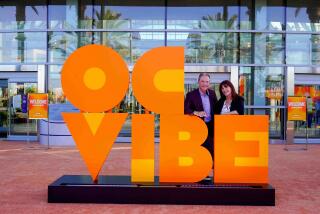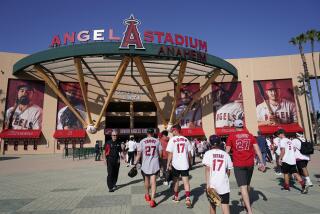Anaheim’s the Latest of NFL Footballs
- Share via
Anaheim Mayor Curt Pringle hasn’t asked, but I have some advice as he pursues a deal to bring an NFL franchise to his city: Lay in plenty of Maalox.
At several points over the next seven months, Pringle and his fellow civic leaders will undoubtedly be led to believe that Anaheim has the inside track to become the National Football League’s next hometown.
The league will encourage them to polish the environmental impact study on the city-owned property proposed for the new stadium, hire consultants and dream of being introduced to a nationwide TV audience at an upcoming Anaheim Super Bowl.
It’s a good bet, however, that several times before the NFL owners vote on a final site next May, the league will seem to turn its back on Anaheim and deliver a wet kiss to one of its rival venues -- the Rose Bowl, the Los Angeles Coliseum or a landfill in Carson.
The NFL generally acts this way just when one locale comes to feel it owns a commanding lead over the others. In May 2003, NFL Commissioner Paul Tagliabue suddenly labeled the Carson project “symmetrical” with Pasadena (that is, equivalent). The Carson venture was barely off the ground, while Pasadena had spent months lining up a financial plan, drafting a Rose Bowl redesign and launching an environmental study. A grander Rose Bowl blueprint more to the league’s taste than the first was subsequently unveiled, with the city’s evident assent.
So it’s unsurprising that one theory about the league’s sudden announcement last week that Anaheim had gotten in the race is that the NFL hopes to keep the other cities off balance and in line as its Oct. 15 deadline for the signing of definitive terms approaches.
Pringle says he’s aware that Anaheim may be getting played as a “flirtation or just leverage -- we’re moving forward with our eyes open.” But he told me he doesn’t truly believe Anaheim is a mere bargaining chip. “Our assumption,” he says, “is they may not have seen what they wanted” at the other sites.
Indeed, it’s possible that the NFL views Anaheim as a legitimate Plan B, knowing it can probably reach a deal there easily if politicians or community leaders in the other cities get too feisty.
The league has addressed skepticism about the timing of its Anaheim announcement with its usual pose of disingenuous bewilderment. When I asked NFL spokesman Greg Aiello whether it wasn’t rather late in the day to express interest in a new venue out of the blue, he replied: “Why would you be surprised? Our job is to identify
potential opportunities. Anaheim hadn’t been our focus before. We decided to broaden our focus.”
He pointed out that the NFL owners are planning to invest as much as $500 million in construction at any L.A.-area venue, and therefore it behooves them to walk the length of the counter, so to speak, before buying.
When I mentioned that people associated with Pasadena and the Rose Bowl seemed irked that the word “Anaheim” never crossed the lips of the NFL representatives who met with them scarcely a week ago to discuss terms -- which is to say several weeks after the league initiated discussions with its new best friend -- Aiello dismissed their reaction almost as self-delusion. “The groups have been told very clearly from the beginning that we would be exploring other sites,” he says.
That’s true, as far as it goes. On Aug. 5, the league sent Pasadena officials a letter stating, in part: “Before the League membership can determine whether to commit an NFL team to the Los Angeles area, we must evaluate the viability of one or more proposed stadium projects.” If City Hall took this to mean the Coliseum and Carson -- the only projects known to exist at the time -- it’s their fault for being naive, isn’t it?
Nevertheless, it’s hard not to view the overture to Anaheim as a hint of the pitfalls the league still sees at each of the three other locations.
The Coliseum is burdened with the byzantine community politics of Los Angeles and the NFL’s unhappy past experience with residency at the stadium. Carson is hamstrung by competing proposals for the site and the potential for a big environmental cleanup bill. And the Rose Bowl is encumbered by historic preservation issues that may limit the scope of a redesign, as well as by a balky local community.
Anaheim glows by comparison. As the home of Disneyland, the city boasts decades of expertise in kissing the behind of a powerful, self-centered corporate bully. There won’t be any talk about preserving the historical character of the place, unless the league proposes to lop the peak off the Matterhorn. There won’t be much neighborhood opposition, because the neighborhood doesn’t exist yet: The designated parcel was previously penciled in as the site of 1,750 apartments and condos, which the city would happily pencil in somewhere else.
On the downside, Anaheim isn’t L.A., only “greater L.A.” The NFL could find it hard to attract Westside money to invest in luxury boxes this far away, or to paper the stands with Hollywood celebrities a la the Lakers.
Still, experts say the NFL is finally determined, for the sake of its up-for-renewal TV contracts and nationwide fan base, to reinstall a team in the nation’s second-largest market. At least one experienced negotiator with the NFL tells me he wouldn’t be surprised to see the league settle for Anaheim if other options falter.
For better or worse, Anaheim is now in play. When I asked Pasadena Mayor Bill Bogaard if he had any advice for Pringle, he replied: “People all recognize that the NFL is not only a highly capable party, but one that places extra importance on economic self-interest.” Then he chuckled. “I don’t think I’m informing Mayor Pringle of anything he doesn’t already know.”
Golden State appears every Monday and Thursday. You can reach Michael Hiltzik at [email protected] and read his previous columns at latimes.com/hiltzik.
More to Read
Go beyond the scoreboard
Get the latest on L.A.'s teams in the daily Sports Report newsletter.
You may occasionally receive promotional content from the Los Angeles Times.











